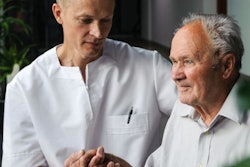
ANAHEIM, CA - In a presentation on May 1 at the California Dental Association's CDA Presents meeting, periodontist Timothy Donley, DDS, spoke about the increasing awareness of the link between oral healthcare and stroke prevention, and what dentists and hygienists can do to help their patients.
Dr. Donley, speaking on the first day of National Stroke Awareness Month, advocated for a new approach in relating this important message to patients.
"It is time for us as a profession to tell our patients that it is vitally important for them to partner with us so we can keep oral inflammation to a minimum," he said at an event sponsored by Philips.
Stressing the long-term benefits of total oral care and walking patients through questions and oral care techniques is a more fruitful approach and, ultimately, a practice builder, he added.
“We need to provide patients with the tools necessary to maximize the chance that inflammation won't return.”
"It's more effective and in everyone's best interests to make the patients partners, rather than lecturing patients to brush and floss 'or else.' We know what the 'or else' is," he said.
Dr. Donley noted that it seems "reasonable at this point to connect the dots" between oral health, inflammation, and an increased risk of stroke.
"It is a great responsibility for us as dentists and hygienists to help patients realize that the mouth can be the source of this inflammation," he said.
He noted that stroke and other cardiovascular events have been found to be inflammation-dependent.
"If we can eliminate inflammation and maintain that in a patient, we can improve their oral and overall health," Dr. Donley said.
This is done through a partnership with patients and by providing them with tools and skills.
"We need to provide patients with the tools necessary to maximize the chance that inflammation won't return," he said. "We need to look at our patients' condition, mouths, and medical history and tell them, 'You are at an increased risk of developing periodontal disease.' "
Practice changes
Dr. Donley said that even after all this time, the basic approach to attacking plaque hasn't really changed. Much of what is done in the dentist's office is scraping plaque.
But can patients reduce or prevent plaque from forming? He cited research on biofilms as an important next step in the prevention of plaque and inflammation. Biofilms have been cited in numerous studies as a key factor in the development of caries and periodontal disease. Dr. Donley said biofilms are not affected by flossing.
 Timothy Donley, DDS, spoke about the connection between periodontal disease and stroke risk at CDA Presents.
Timothy Donley, DDS, spoke about the connection between periodontal disease and stroke risk at CDA Presents."We need to help patients understand that biofilm is microscopic," he said. "If biofilms grow to when they are visible, it's plaque. We have to make sure patients are equipped to maximize the elimination of etiology in all forms."
But how, in an age where a dental office is being told to practice infection control, take blood pressure, and handle a dozen other patient-health related measures, can a busy practice accomplish this important conversation with patients about periodontal disease and long-term health consequences?
Dr. Donley said that his office in Bowling Green, KY, uses a health history form that is written in a way that educates and motivates patients. This history also includes a risk profile, which sites have inflammation, and what has been done in the past for those sites.
"It's an issue," he told DrBicuspid.com. "What should dentists and hygienists tell patients?"
He recommends telling patients -- in language they will understand -- that if their periodontal disease is left untreated, the damage could get worse.
"The next message to the patient is: If the damage gets worse, that increases the risk for serious systemic problems," he said.
Insurance companies also need to be involved, he noted.
"Actuaries have demonstrated that you save a significant amount of money longer-term with these treatments," Dr. Donley said.



















